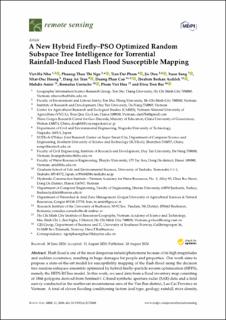| dc.contributor.author | Viet-Ha, Nhu | |
| dc.contributor.author | Phuong-Thao Thi, Ngo | |
| dc.contributor.author | Tien Dat, Pham | |
| dc.contributor.author | Jie, Dou | |
| dc.contributor.author | Xuan, Song | |
| dc.contributor.author | Nhat-Duc, Hoang | |
| dc.contributor.author | Dang An, Tran | |
| dc.contributor.author | Duong Phan, Cao | |
| dc.contributor.author | İbrahim Berkan, Aydilek | |
| dc.contributor.author | Mahdis, Amiri | |
| dc.contributor.author | Romulus, Costache | |
| dc.contributor.author | Pham Viet, Hoa | |
| dc.contributor.author | Tien Bui, Dieu | |
| dc.date.accessioned | 2021-04-07T13:00:15Z | |
| dc.date.available | 2021-04-07T13:00:15Z | |
| dc.date.created | 2020-08-30T18:52:56Z | |
| dc.date.issued | 2020 | |
| dc.identifier.citation | Nhu, V. H., Thi Ngo, P. T., Pham, T. D., Dou, J., Song, X., Hoang, N. D., ... & Tien Bui, D. (2020). A new hybrid firefly–PSO optimized random subspace tree intelligence for torrential rainfall-induced flash flood susceptible mapping. Remote Sensing, 12(17). | en_US |
| dc.identifier.issn | 2072-4292 | |
| dc.identifier.uri | https://hdl.handle.net/11250/2736672 | |
| dc.description.abstract | Flash flood is one of the most dangerous natural phenomena because of its high magnitudes and sudden occurrence, resulting in huge damages for people and properties. Our work aims to propose a state-of-the-art model for susceptibility mapping of the flash flood using the decision tree random subspace ensemble optimized by hybrid firefly–particle swarm optimization (HFPS), namely the HFPS-RSTree model. In this work, we used data from a flood inventory map consisting of 1866 polygons derived from Sentinel-1 C-band synthetic aperture radar (SAR) data and a field survey conducted in the northwest mountainous area of the Van Ban district, Lao Cai Province in Vietnam. A total of eleven flooding conditioning factors (soil type, geology, rainfall, river density, elevation, slope, aspect, topographic wetness index (TWI), normalized difference vegetation index (NDVI), plant curvature, and profile curvature) were used as explanatory variables. These indicators were compiled from a geological and mineral resources map, soil type map, and topographic map, ALOS PALSAR DEM 30 m, and Landsat-8 imagery. The HFPS-RSTree model was trained and verified using the inventory map and the eleven conditioning variables and then compared with four machine learning algorithms, i.e., the support vector machine (SVM), the random forests (RF), the C4.5 decision trees (C4.5 DT), and the logistic model trees (LMT) models. We employed a range of statistical standard metrics to assess the predictive performance of the proposed model. The results show that the HFPS-RSTree model had the best predictive performance and achieved better results than those of other benchmarks with the ability to predict flash flood, reaching an overall accuracy of over 90%. It can be concluded that the proposed approach provides new insights into flash flood prediction in mountainous regions. | en_US |
| dc.language.iso | eng | en_US |
| dc.relation.uri | https://www.mdpi.com/2072-4292/12/17/2688 | |
| dc.rights | Navngivelse 4.0 Internasjonal | * |
| dc.rights.uri | http://creativecommons.org/licenses/by/4.0/deed.no | * |
| dc.title | A New Hybrid Firefly–PSO Optimized Random Subspace Tree Intelligence for Torrential Rainfall-Induced Flash Flood Susceptible Mapping | en_US |
| dc.type | Peer reviewed | en_US |
| dc.type | Journal article | en_US |
| dc.description.version | publishedVersion | en_US |
| dc.rights.holder | © The Author(s). | en_US |
| dc.source.volume | 12 | en_US |
| dc.source.journal | Remote Sensing | en_US |
| dc.source.issue | 17 | en_US |
| dc.identifier.doi | https://doi.org/10.3390/rs12172688 | |
| dc.identifier.cristin | 1826075 | |
| dc.source.articlenumber | 2688 | en_US |
| cristin.ispublished | true | |
| cristin.fulltext | original | |
| cristin.qualitycode | 1 | |

